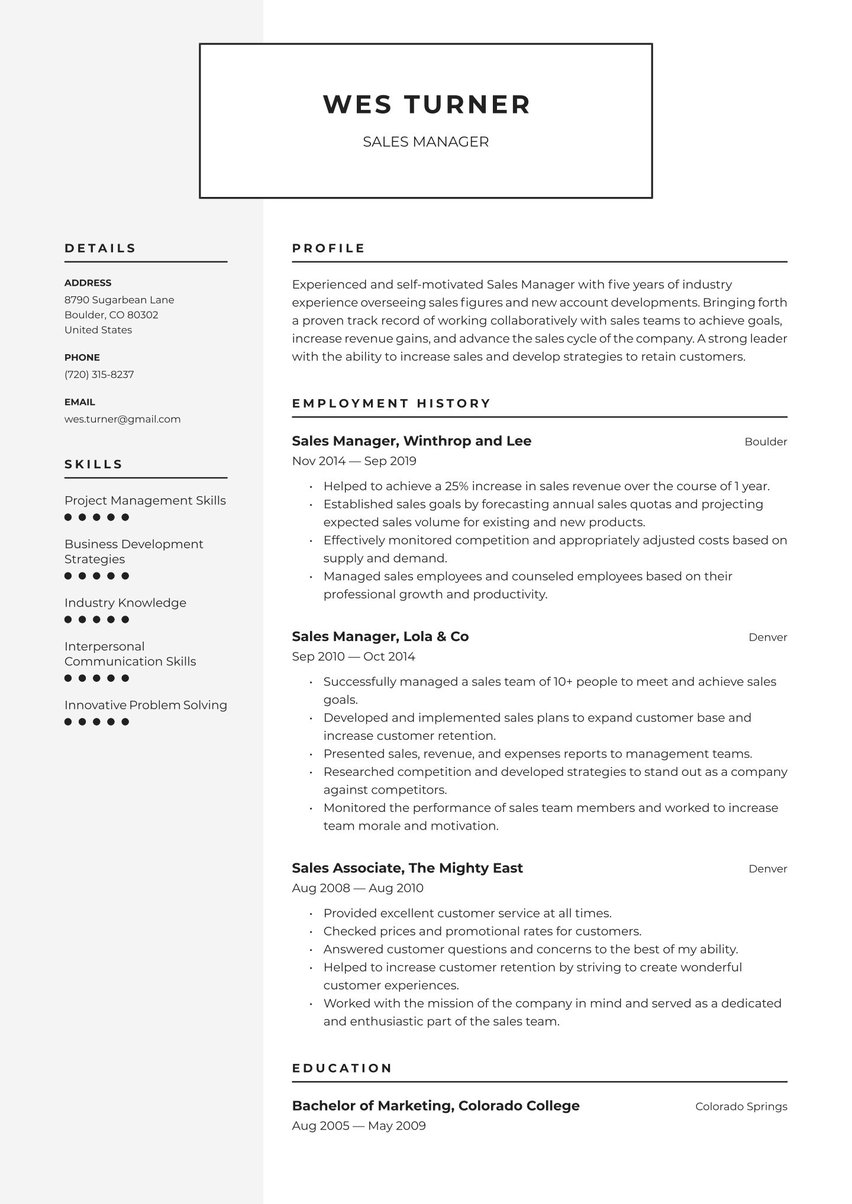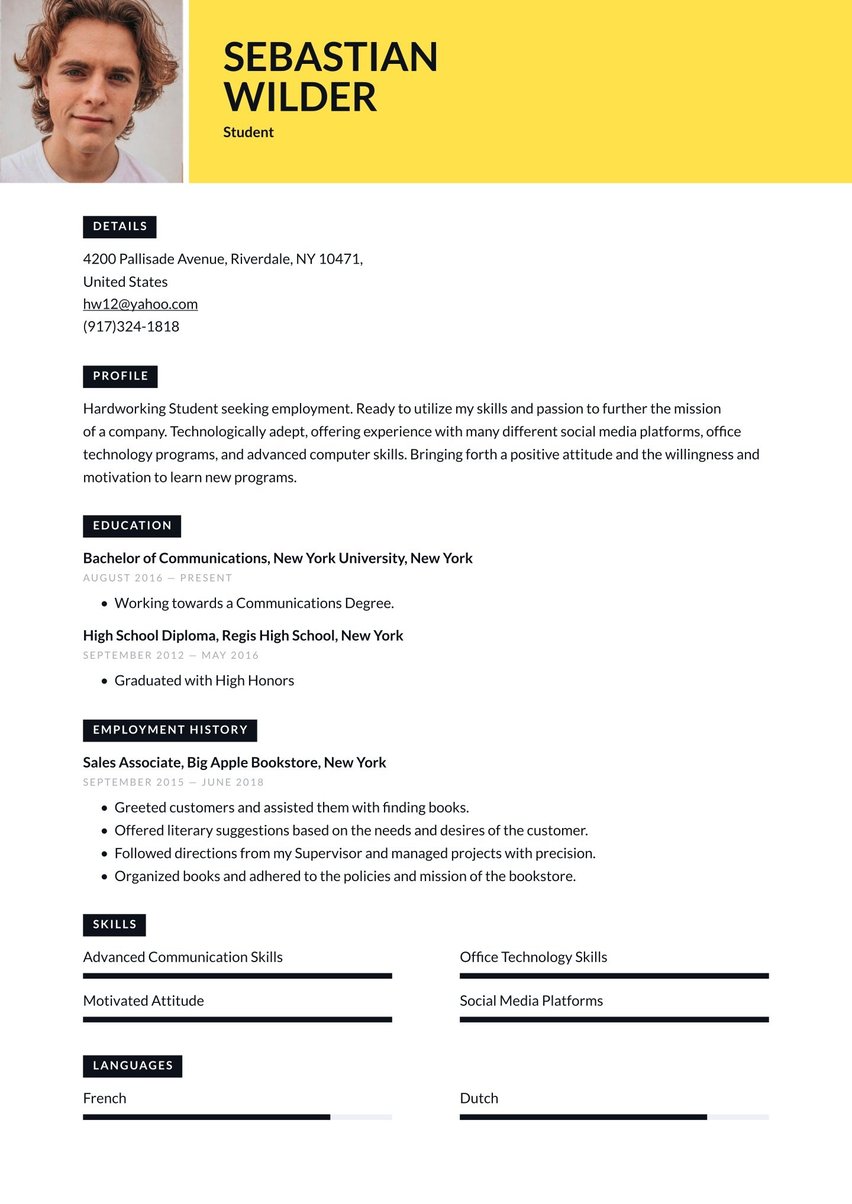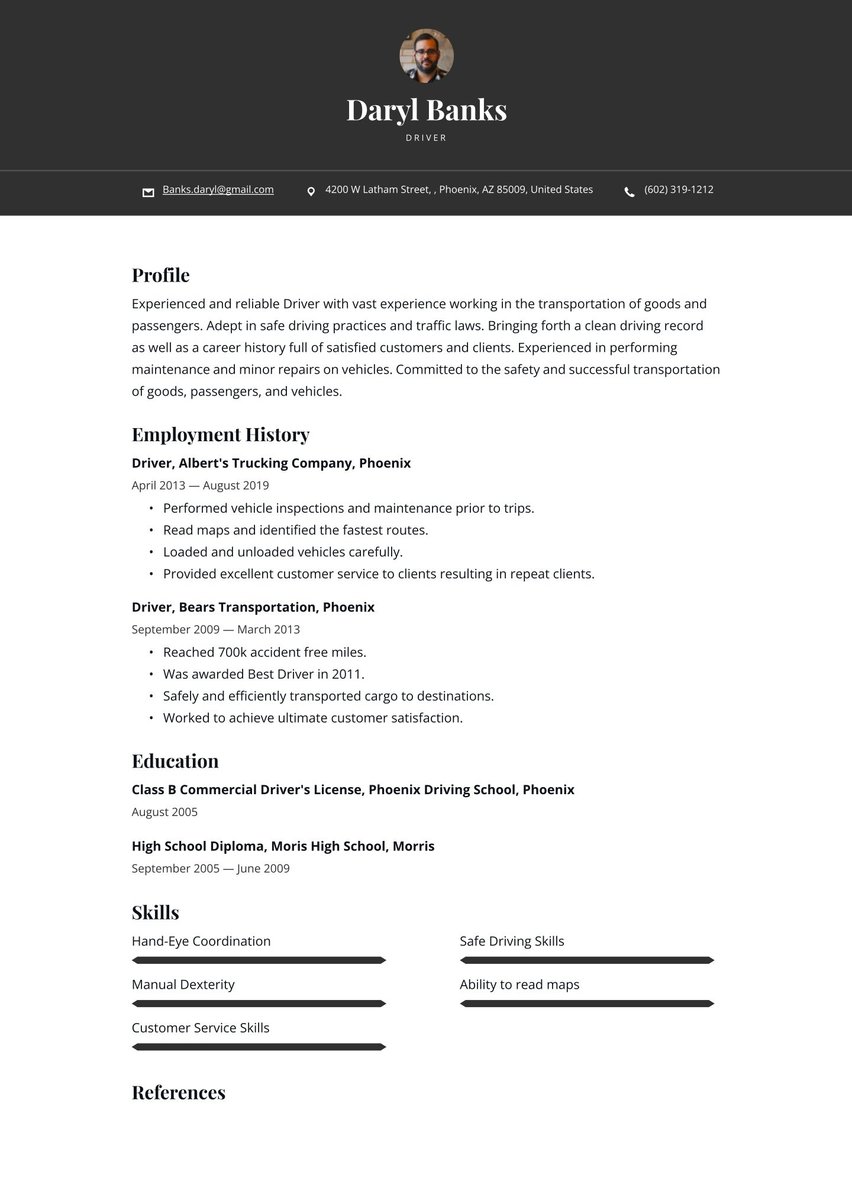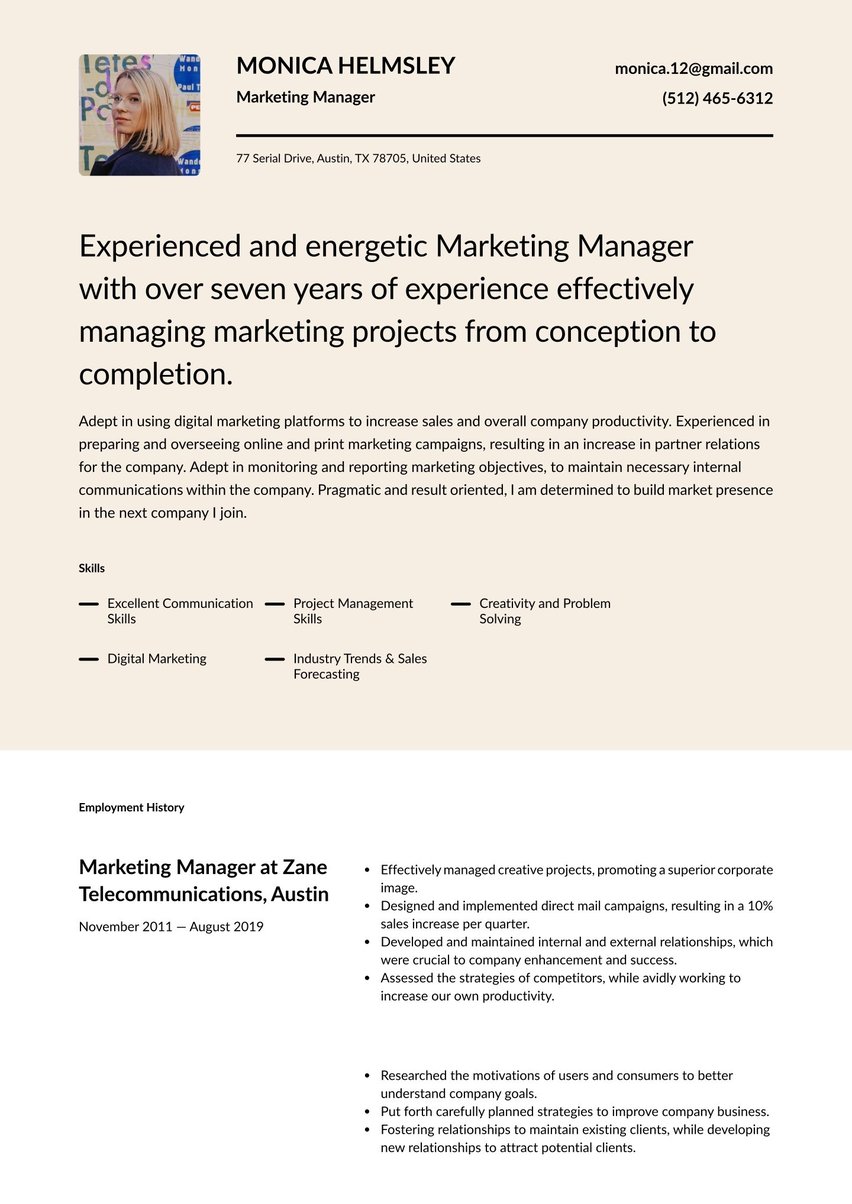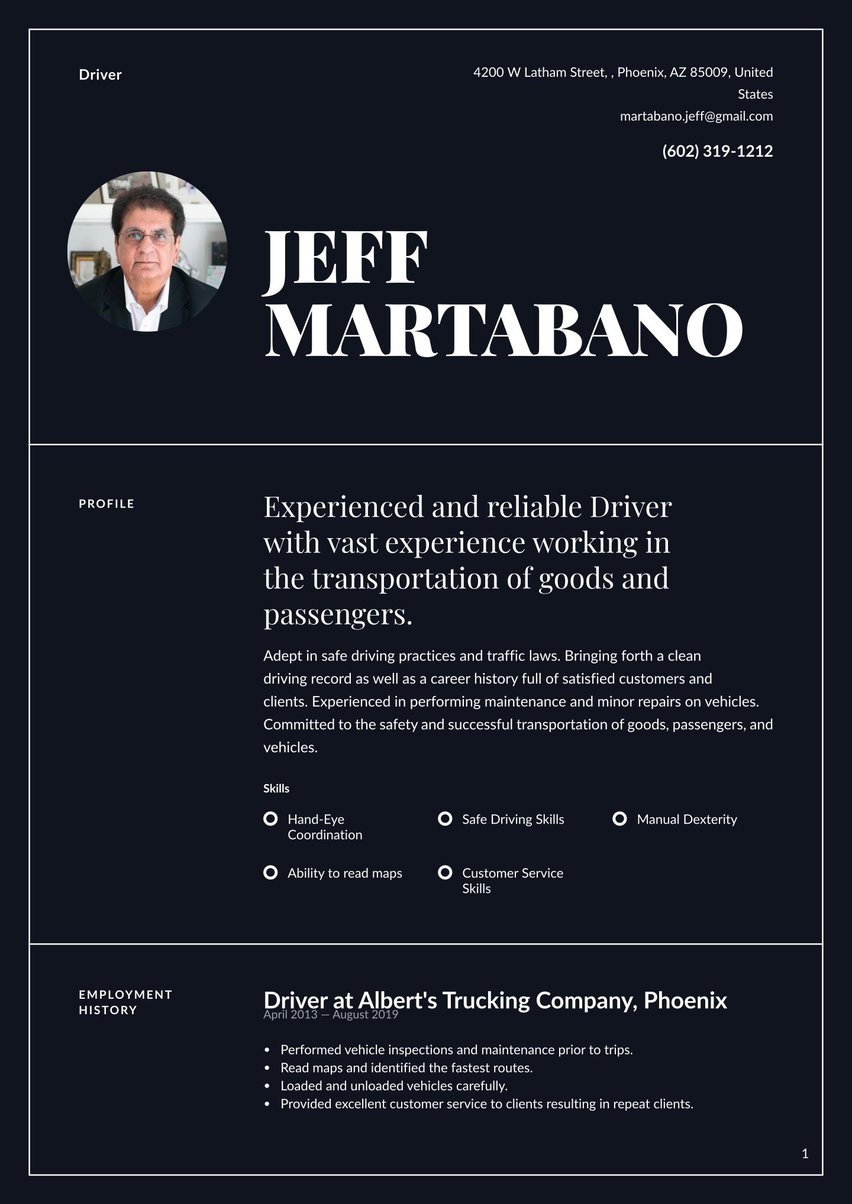Detail-oriented and resourceful Clinical Research Coordinator with a wealth of experience in overseeing and conducting clinical trials. Proven track record of ensuring all research is conducted in compliance with protocol and regulatory requirements. Demonstrated talent for successfully multi-tasking in a high-paced environment.
06/2017 - present, Clinical Research Coordinator, Atrium Health, Seattle, WA
- Manage logistics for clinical trials, ensuring alignment with regulatory guidelines.
- Coordinate with internal departments to ensure smooth progress of research projects.
- Assist in the preparation and submission of regulatory documents.
08/2015 - 05/2017, Research Assistant, Antioch University, Seattle
- Conducted literature reviews to support key research projects.
- Aided data collection activities, ensuring data accuracy and management.
- Assisted in the development of experiments to test hypotheses, resulting in more accurate and reliable research results.
08/2011 - 05/2015, Master of Science in Clinical Research, Washington State University, Pullman, WA
08/2007 - 05/2011, Bachelor of Science in Biology, Washington State University, Pullman, WA
- Clinical Trial Coordination
- Regulatory Compliance
- Data Management
- Written & Verbal Communication
- Collaborative Team Player
- Fluent in English & Spanish
- Literature Reviews
- Clinical Trial Logistics
As a clinical research coordinator, you have big shoes to fill. It’s your job to make sure that every element of a study—from its inception to the end—goes smoothly. To do so, you need to have a diverse skill set, the right education, and a wealth of clinical trial experience. But how can you showcase your range on a one or two-page document?
Clinical Research Coordinator resume examples by experience level
Here at Resume.io, we want to help you supercharge your job search. If you need some extra help, you’ve come to the right place. We have everything you need to make landing your next role a breeze, including 350+ resume examples and accompanying writing guides. In the following writing guide and resume sample, you can expect to learn:
- What a clinical research coordinator does
- How to write a stellar application (with a resume example!)
- Expert-backed tips on what to include on each resume section
- How to choose the right format for your resume
- Design and layout advice to make you stand out from the crowd
If you need the basics refreshing, we’ve got you covered. Check out our general resume writing guide to get the inside scoop on how to get started.
What does a clinical research coordinator do?
Clinical research coordinators are at the helm of any study. You are the person who makes sure that every element of the trial goes to plan. For that reason, you need to have top-notch organizational skills, communication skills, and the ability to multitask. On any given day in the office, you might find that your “to do” list includes the following:
- Recruiting participants for upcoming studies and research trials
- Screening each new participant and ensuring they meet the criteria
- Oversee the running of the clinical trials in real-time
- Manage the researchers and liaise across departments
- Create and often present reports recounting the study results
Of course, the day-to-day duties that you will encounter will depend largely on what type of trial you are involved in. However, it’s important to understand what the core tasks may be.
How much do clinical research coordinators make?
If you want to take a step-up to the clinical research coordinator role, you may be wondering how much cash you will take home. According to Career Explorer, these professionals make an average of $137,900 per year.
Needless to say, the exact salary you can expect will depend on your experience level and the field you are in. As you climb the career ladder, you can expect to demand higher pay.
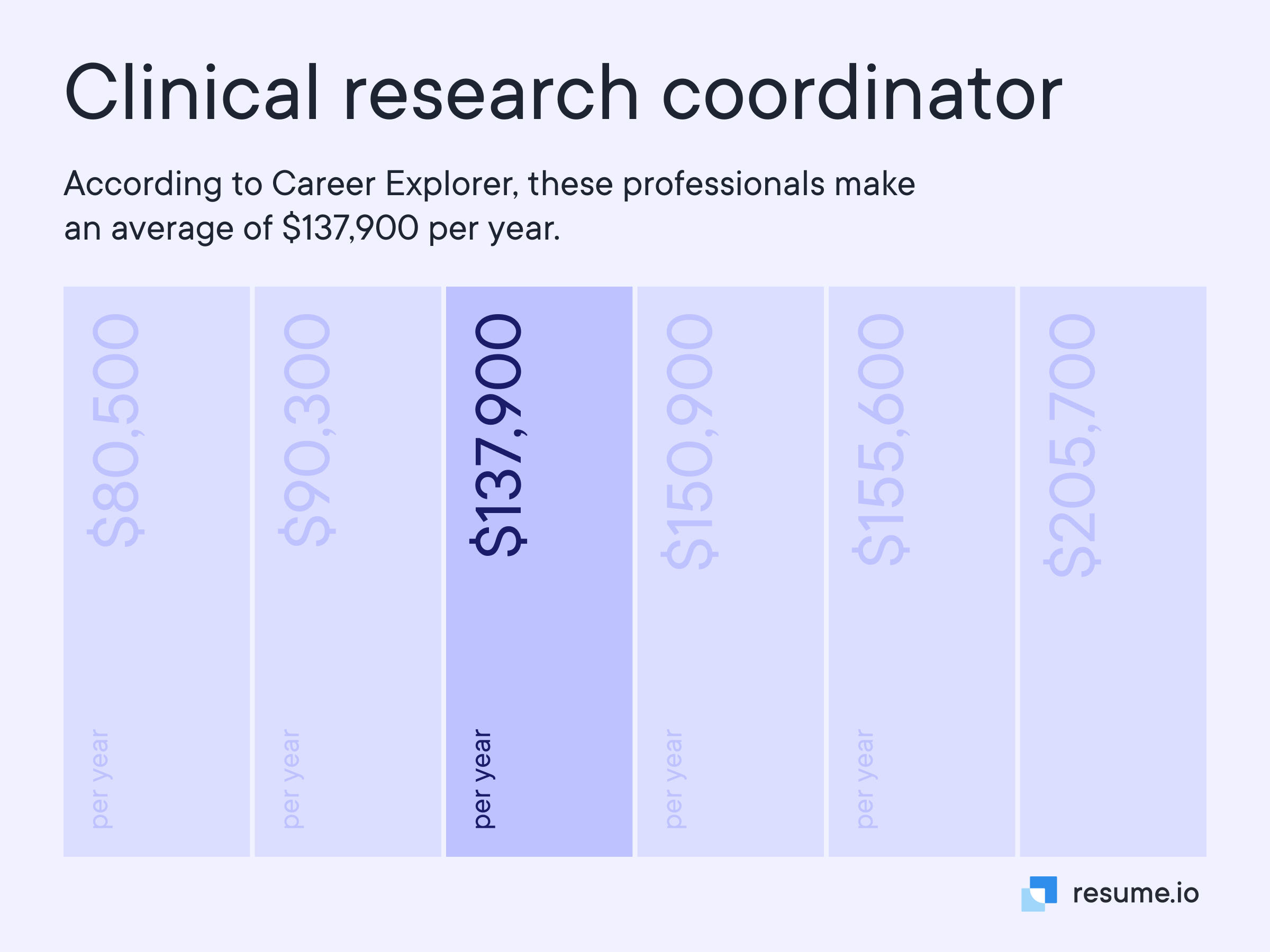
How to write a clinical research coordinator resume
Before you work on your resume, you need to know what elements to feature. Luckily, there’s a standard structure that you should use. Here’s what you need to include:
- The resume header
- The resume summary (aka profile or personal statement)
- The employment history section
- The resume skills section
- The education section
If you follow the above structure, your resume will be easy to understand. Hiring managers expect to see each of these sections when they look at applications. It’s your job to make it as straightforward as it can be for them. Including these elements is the way to go here.
Always re-read your resume before you submit it. When you are writing an application, attention to detail is everything. You need to make sure that each part of your resume is perfect. If you have silly spelling mistakes or grammatical problems in there, they will reflect badly on you. For that reason, it’s worth the extra effort of proofreading your resume.
Optimize your clinical research coordinator resume!
Many businesses now use applicant tracking systems (ATS) to filter the applications that they receive. The software scans resumes for relevant keywords. Only the top applications get through the filter and end up in the hiring manager’s inbox to be reviewed.
If you want to make sure that your resume beats the bots, you should optimize it. To do so, take a look at the original job posting. Pick out any keywords or phrases listed there. You should weave these through your application for the best chance of success.
Choosing the best resume format for a clinical research coordinator
Next up, you should decide what format to use for your resume. Most of the time, a reverse chronological structure works the best. This approach involves putting your most recent qualifications and experiences at the top of the page. As you move down the page, you should simultaneously work your way back in time. Hiring managers expect candidates to use this structure in most cases. For that reason, it is a safe bet.
Of course, there are always exceptions to this rule. If you think that a different resume format would be more appropriate, take a look at our full formatting guide here for more details.
Looking for some inspiration? Take a look at our related resume examples and guides:
- Healthcare resume sample
- CNA resume sample
- Lactation Consultant resume sample
- Epidemiologist resume sample
- Health Care Administration resume sample
- Dental Receptionist resume sample
- Endodontist resume sample
- Nursing Home resume sample
- Audiologist resume sample
- Respiratory Therapist resume sample
- Physician Assistant resume sample
- Clinic Coordinator resume sample
- Medical Receptionist resume sample
- Optometrist resume sample
- Physical Therapist resume sample
- Pharmacist resume sample
- Sonographer resume sample
- Psychotherapist resume sample
- Medical Science Liaison resume sample
- Dental Assistant resume sample
- Paramedic resume sample
- Doctor resume sample
Resume summary example
The resume summary is often the first thing a hiring manager will read. It’s a 3-4 line blurb that sits at the top of your application. As the most free form part of your resume, it offers the most room for creativity. Take the time to consider what your main selling point is—what is it that sets you apart from the crowd? You can lead with this key information as a hook.
You should also include quantified facts in your resume summary. This approach shows the hiring manager what value you will bring to the table. If you’re unsure where to start, take a look at our resume summary example for an idea of what you could write.
Detail-oriented and resourceful Clinical Research Coordinator with a wealth of experience in overseeing and conducting clinical trials. Proven track record of ensuring all research is conducted in compliance with protocol and regulatory requirements. Demonstrated talent for successfully multi-tasking in a high-paced environment.
Employment history sample
Whether you have 10+ years of experience or just a couple, you need to write a stellar employment history section. Include around three of your prior positions in this section. You need to get the basics right first. That means including the name of the business at which you worked, your role, and your years of employment. Beneath that, you can add in bullet point sentences describing the main duties you undertook or special accomplishments.
Clinical Research Coordinator at Atrium Health, Seattle, WA
June 2017 - Present
- Manage logistics for clinical trials, ensuring alignment with regulatory guidelines.
- Coordinate with internal departments to ensure smooth progress of research projects.
- Assist in the preparation and submission of regulatory documents.
Research Assistant at Antioch University, Seattle
August 2015 - May 2017
- Conducted literature reviews to support key research projects.
- Aided data collection activities, ensuring data accuracy and management.
- Assisted in the development of experiments to test hypotheses, resulting in more accurate and reliable research results.
Resume skills example
As we have already covered, you will need a diverse skill-set to become a clinical research coordinator. Be sure to include both hard and soft skills in this part of your application. Hard skills—sometimes known as technical proficiencies—apply directly to your field. On the other hand, soft skills are often transferable skills. Hiring managers are looking for well-rounded candidates to employ. For that reason, include a healthy mixture of both.
- Clinical Trial Coordination
- Regulatory Compliance
- Data Management
- Written & Verbal Communication
- Collaborative Team Player
- Fluent in English & Spanish
- Literature Reviews
- Clinical Trial Logistics
Clinical research coordinator resume education example
Your education matters if you want to become a clinical research coordinator. You will most likely need a science-based degree to land this job. List your qualifications in your education section. You don’t need to go into a wealth of detail here. Simply include the institute, the years you studied, and the qualification you gained. Should you want to slide in some extra detail, you can use a bullet point below these headers.
Master of Science in Clinical Research, Washington State University, Pullman, WA
August 2011 - May 2015
Bachelor of Science in Biology, Washington State University, Pullman, WA
August 2007 - May 2011
Resume layout and design
Your number one goal is to make your resume readable. So, you should avoid overly flashy or colorful resume designs. Instead, choose a simple layout with plenty of white space. When it comes to the font style, opt for something that will not bamboozle the reader. It should be clear on both a screen or print-out, for instance. If you tick all of these boxes, you should find that your application wows any hiring manager with its content.
Clinical Research Coordinator text-only resume example
Profile
Detail-oriented and resourceful Clinical Research Coordinator with a wealth of experience in overseeing and conducting clinical trials. Proven track record of ensuring all research is conducted in compliance with protocol and regulatory requirements. Demonstrated talent for successfully multi-tasking in a high-paced environment.
Employment history
Clinical Research Coordinator at Atrium Health, Seattle, WA
June 2017 - Present
- Manage logistics for clinical trials, ensuring alignment with regulatory guidelines.
- Coordinate with internal departments to ensure smooth progress of research projects.
- Assist in the preparation and submission of regulatory documents.
Research Assistant at Antioch University, Seattle
August 2015 - May 2017
- Conducted literature reviews to support key research projects.
- Aided data collection activities, ensuring data accuracy and management.
- Assisted in the development of experiments to test hypotheses, resulting in more accurate and reliable research results.
Skills
- Clinical Trial Coordination
- Regulatory Compliance
- Data Management
- Written & Verbal Communication
- Collaborative Team Player
- Fluent in English & Spanish
- Literature Reviews
- Clinical Trial Logistics
Education
Master of Science in Clinical Research, Washington State University, Pullman, WA
August 2011 - May 2015
Bachelor of Science in Biology, Washington State University, Pullman, WA
August 2007 - May 2011
Key takeaways for a research coordinator resume
- As a clinical research coordinator, you need to have a broad selection of skills. Make sure you showcase them in the best possible way.
- Always proofread your resume content. Grammatical errors and spelling mistakes can be more costly than you might imagine.
- Optimize your resume for the applicant tracking system (ATS) by including a selection of keywords and phrases.
Make sure the content stands out by using a clear and simple design. If in doubt, use one of our field-tested resume templates and wow the hiring manager.


.jpg)

.jpg)



















